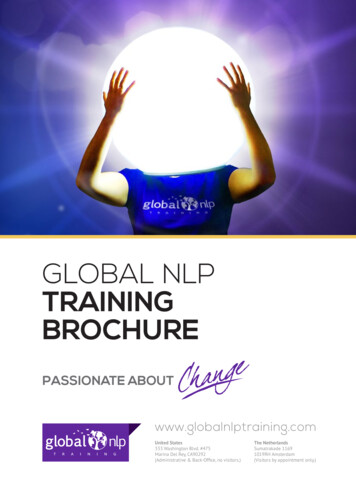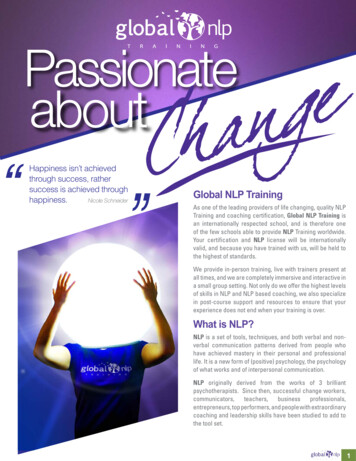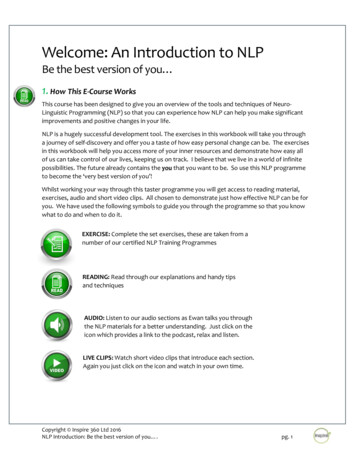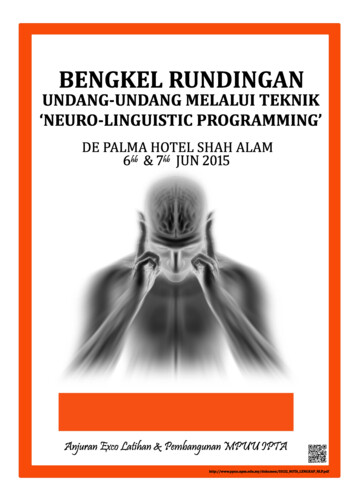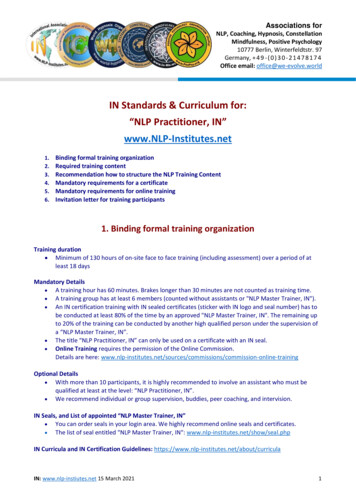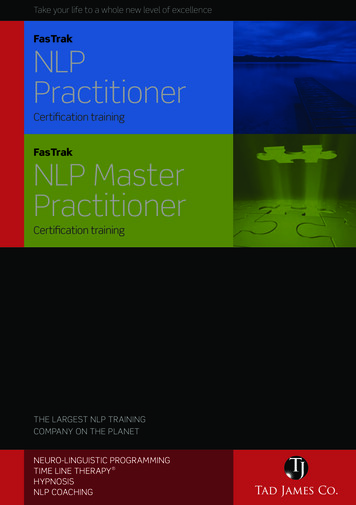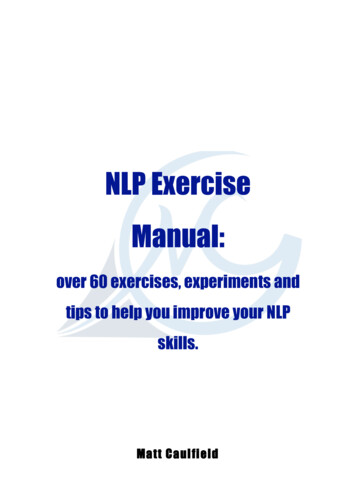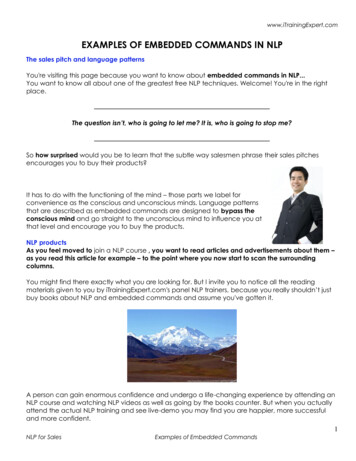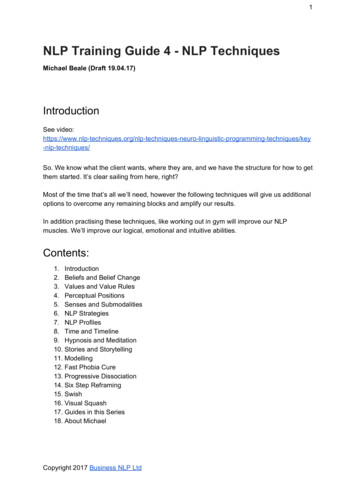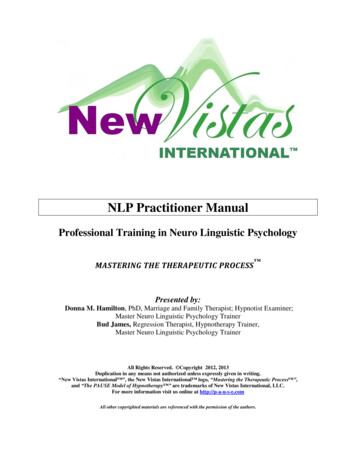
Transcription
NLP Practitioner ManualProfessional Training in Neuro Linguistic PsychologyMASTERING THE THERAPEUTIC PROCESS Presented by:Donna M. Hamilton, PhD, Marriage and Family Therapist; Hypnotist Examiner;Master Neuro Linguistic Psychology TrainerBud James, Regression Therapist, Hypnotherapy Trainer,Master Neuro Linguistic Psychology TrainerAll Rights Reserved. Copyright 2012, 2013Duplication in any means not authorized unless expressly given in writing.“New Vistas International ”, the New Vistas International logo, “Mastering the Therapeutic Process ”,and “The PAUSE Model of Hypnotherapy ” are trademarks of New Vistas International, LLC.For more information visit us online at http://p-a-u-s-e.comAll other copyrighted materials are referenced with the permission of the authors.
NLP – Neuro Linguistic Psychology Manual - PractitionerTable of ContentsINTRODUCTION .6NEURO-LINGUISTIC PROGRAMMING/PSYCHOLOGY - .6THE STUDY OF SUBJECTIVE EXPERIENCE .6VALUE OF NLP.7NLP COMMUNICATION MODEL .8FIVE SUCCESS PRINCIPLES.9STATE VERSUS BEHAVIOR EXERCISE .11HISTORY OF NLP . 13THE FOUR STAGES OF COMPETENCE .14THE BASIC PRESUPPOSITIONS OF THE NLP MODEL . 16THE PRESUPPOSITIONS OF NLP .17A DEEPER DIVE INTO EACH OF THE PRESUPPOSITIONS .18OUTCOMES. 23SUCCESSFULLY SETTING WELL-FORMED OUTCOMES .26OUTCOME QUESTIONS .27Questions to ask oneself for effective outcome based thinking .28Wheel of Fortune.29STATE VERSUS OUTCOMES .30RAPPORT . 31THE BASIS OF RAPPORT .32RAPPORT INDICATORS .34RAPPORT SUMMARY .35PRACTICING RAPPORT.36PACING AND LEADING . 37Examples of Pacing & Leading .38REPRESENTATIONAL SYSTEMS – PREDICATES. 39SENTENCE STRUCTURES – PREDICATES . 42VISUAL (V) .42AUDITORY (A) .42KINESTHETIC (K) .42AUDITORY DIGITAL (AD) OR SELF-TALK .43Auditory Digital (AD) Words .43Auditory Digital (AD) Phrases .43PREDICATE EXERCISES .44NLP MODEL OF THERAPY. 45ANCHORING . 46FOUR KEYS TO A WELL-FORMED ANCHOR .46WHEN TO USE ANCHORING .47Some General Points To Keep In Mind .47BASIC OPTIONS FOR THE USE OF ANCHORING .48SHORT FORM .48BASIC OPTIONS FOR THE USE OF ANCHORING .49SENSORY ACUITY . 50BMIRS: BEHAVIORAL MANIFESTATIONS OF INTERNAL REPRESENTATIONS .50ACCESSING CUES .51THE META MODEL. 52DEVELOPED BY RICHARD BANDLER AND JOHN GRINDER .52Deep structure/ Surface structure .52THE THREE ELEMENTS OF THE NLP META MODEL .53Elements of language that delete experience. .54NVI.NLPM.V15Mastering the Therapeutic Process - All Rights Reserved, New Vistas International , 2012, 13Page 2
NLP – Neuro Linguistic Psychology Manual - PractitionerDISTORTIONS .55GENERALIZATIONS .56DELETIONS .57META MODEL . 59SHORT FORM .59DISTORTIONS: .59GENERALIZATIONS: .59DELETIONS: .59CHAINING ANCHORS: CHAIN DESIGN . 60CHAINING ANCHORS: CHAIN INSTALLATION .61COLLAPSE ANCHOR OUTLINE .62SHORT FORM .62COLLAPSE ANCHOR OUTLINE .63SUBMODALITIES . 65MODALITIES – SUBMODALITIES – DRIVERS .66QUESTIONS TO ELICIT SUBMODALITIES .67USING THE SUBMODALITIES CHECKLIST .68Processing a Challenge to their Goal .68SUBMODALITY CHECKLIST.69Visual .69Auditory .69Auditory Digital .69Kinesthetic .69EYE ACCESSING CUES . 71Eye Pattern Introduction .71Eye Pattern Diagram .72Discovering Eye Patterns .73Activating Eye Patterns .74USING EYE PATTERNS .75Using Eye Patterns (2) .76Using Eye Patterns (3) .77SENSORY PREDICATES AND EYE ACCESSING CUES .79EYE ACCESSING ELICITATION .80REPRESENTATIONAL SYSTEMS . 81LEAD OR PRIMARY REPRESENTATIONAL SYSTEM .82REPRESENTATIONAL SYSTEM CHARACTERISTICS .83SYNESTHESIA – OVERLAPPING REPRESENTATIONS . 85Overlap .85MODELING . 87MAP ACROSS . 88SWISH PATTERN. 89SWISH PATTERN REVISED .90BELIEF CHANGE THROUGH SUBMODALITY SHIFTS . 92PHOBIA MODEL USING SUBMODALITY SHIFTS.93LANGUAGING . 94LINGUISTIC PRESUPPOSITIONS .94LINGUISTIC PRESUPPOSITIONS .95LINGUISITIC PRESUPPOSITIONS - EXERCISE .97THE MILTON MODEL . 99THE HYPNOTIC LANGUAGE PATTERNS OF MILTON H. ERICKSON, MD .99SHORT FORM .103HIERARCHY OF IDEAS . 104LOGICAL LEVELS OF ABSTRACTION.104NVI.NLPM.V15Mastering the Therapeutic Process - All Rights Reserved, New Vistas International , 2012, 13Page 3
NLP – Neuro Linguistic Psychology Manual - PractitionerCHUNKING . 105QUESTIONS TO CHANGE LOGICAL LEVELS .105OUTFRAMING . 106STRATEGIES . 107NLP NOTATION .107REPRESENTATIONAL SYSTEMS .107SYNTACTIC SYMBOLS .107STRATEGIES . 108STRUCTURAL WELL–FORMEDNESS CONDITIONS . 109TIPS FOR EFFECTIVE STRATEGY ELICITATION . 110FORMAL STRATEGY ELICITATION . 111ELICITATION QUESTIONS . 112INSTALLATION METHODS: .112TYPICAL PROBLEMS WITH DECISION STRATEGIES. 113MOTIVATION STRATEGIES . 114TYPICAL MOTIVATIONAL STRATEGIES: .114TYPICAL COMPONENTS OF AN EFFECTIVE MOTIVATION STRATEGY: .114EXAMPLE OF A GOOD MOTIVATIONAL STRATEGY: .115TYPICAL PROBLEMS WITH MOTIVATION STRATEGIES: .115SPELLING STRATEGIES . 116STEPS .116SPELLING ELICITATION: .116BAD SPELLING STRATEGIES: .116GOOD SPELLING STRATEGY: .116INSTALLATION: .117COMMON PROBLEMS WITH SPELLING STRATEGIES: .117WELL-FORMEDNESS CONDITIONS FOR LEARNING STRATEGIES .118SHORT FORM .118WELL-FORMEDNESS CONDITIONS FOR LEARNING STRATEGIES .119WELL-FORMEDNESS CONDITIONS: .120ELICITATION QUESTIONS FOR LEARNING STRATEGIES .120CONTEXT: .120INITIAL TEST/TRIGGER: .120OPERATION: .120SECOND TEST: .120EXIT: .120RECOVERY STRATEGY . 121FUTURE PACING TO BUILD RECURSION.121FUTURE PACING . 122WHY FUTURE PACE? .124VISUAL-KINESTHETIC DISSOCIATION . 126SHORT FORM .126VISUAL-KINESTHETIC DISSOCIATION . 127(R. Bandler & J. Grinder) .127CHANGE PERSONAL HISTORY . 128RE–IMPRINT METHOD . 129REFRAMING . 130BASIC PRESUPPOSITION .130TWO TYPES OF REFRAMING .130Important .130SIX-STEP REFRAME .131SIX-STEP REFRAME REVISED .132NVI.NLPM.V15Mastering the Therapeutic Process - All Rights Reserved, New Vistas International , 2012, 13Page 4
NLP – Neuro Linguistic Psychology Manual - PractitionerAGREEMENT FRAME . 134VISUAL SQUASH . 135METAPHORS . 136METAPHOR CONSTRUCTION .136NLP - A MODEL OF COMMUNICATION AND PERSONALITY . 138DELETION: .138DISTORTION: .138GENERALIZATION: .139META-PROGRAMS: .139VALUES: .139BELIEFS: .140MEMORIES: .140DECISIONS: .140RECOMMENDED REVIEW SCHEDULE FOR EASY LONG–TERM MEMORY STORAGE .141CERTIFICATION STANDARDS . 142PRACTITIONER LEVEL STANDARDS .142MASTER PRACTITIONER LEVEL .144TRAINER LEVEL .147NVI.NLPM.V15Mastering the Therapeutic Process - All Rights Reserved, New Vistas International , 2012, 13Page 5
NLP – Neuro Linguistic Psychology Manual - PractitionerINTRODUCTIONNEURO-LINGUISTIC PROGRAMMING/PSYCHOLOGY THE STUDY OF SUBJECTIVE EXPERIENCEFrom the New Vistas Glossary:NLP (Neuro-Linguistic Programming/Psychology): The science of modeling people(studying and imitating) to produce similar results in others. Defined in the Oxford EnglishDictionary as "a model of interpersonal communication chiefly concerned with therelationship between successful patterns of behavior and the subjective experiences (esp.patterns of thought) underlying them" and "a system of alternative therapy based on thiswhich seeks to educate people in self-awareness and effective communication, and tochange their patterns of mental and emotional behavior".The co-founders, Richard Bandler and linguist John Grinder, claimed it would be instrumental in"finding ways to help people have better, fuller and richer lives". They were right. They coinedthe title to denote a connection between neurological processes ('Neuro'), language ('Linguistic')and behavioral patterns that have been learned or observed through experience('Programming/Psychology') and that can be organized to achieve specific goals in life.Psychology: (lit. "study of the soul" or "study of the mind") is an academic and applieddiscipline which involves the scientific study of human or animal mental functions andbehaviors. In the field of psychology, a professional researcher or practitioner is called apsychologist, and is a type of social scientist.“NLP is an attitude and a methodology that leaves behind a trail oftechniques.”Richard BandlerThe Attitude:CuriosityWanton ExperimentationThe Methodology:Modeling – the extrication and replication of eleganceThe Question:How is it possible? Possible in the world, possible for me is only aquestion of “how”NVI.NLPM.V15Mastering the Therapeutic Process - All Rights Reserved, New Vistas International , 2012, 13Page 6
NLP – Neuro Linguistic Psychology Manual - PractitionerVALUE OF NLPWe have incorporated Neuro Linguistic Psychology (NLP) tools throughout the entire NewVistas International training program. Why? Because it works! There are many, manydifferent therapeutic approaches available to us today. NLP is one of the most profound, easilyused, efficient, repeatable, and effective forms of effecting positive permanent change in our
NLP – Neuro Linguistic Psychology Manual - Practitioner NVI.NLPM.V15 Maste ring the Therapeutic Process - All Ri ghts Reserved, New Vistas
